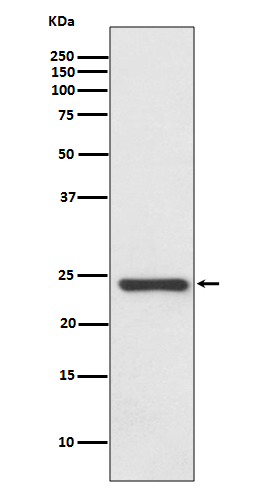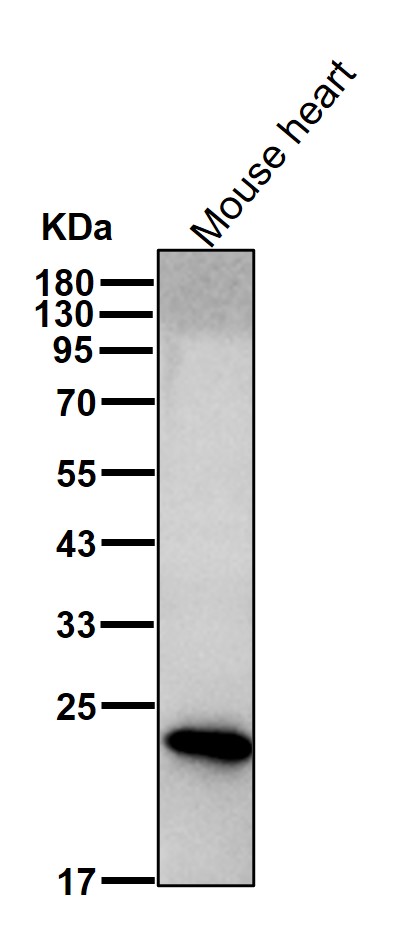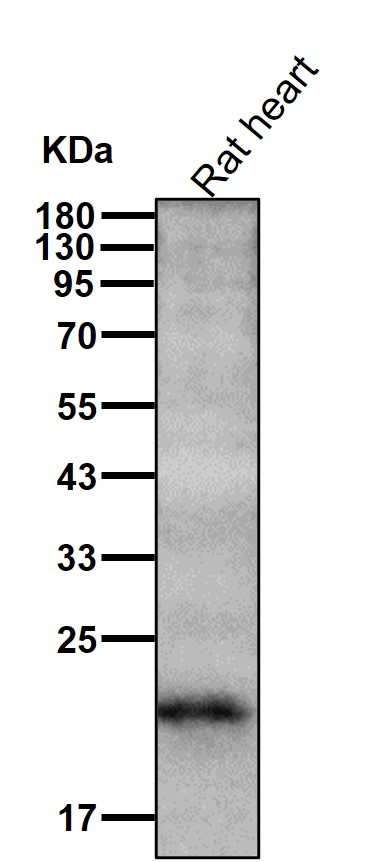


| WB | 咨询技术 | Human,Mouse,Rat |
| IF | 咨询技术 | Human,Mouse,Rat |
| IHC | IHC:1/100-1/200;IHF:1/50-1/200 | Human,Mouse,Rat |
| ICC | 1/50-1/200 | Human,Mouse,Rat |
| FCM | 咨询技术 | Human,Mouse,Rat |
| Elisa | 咨询技术 | Human,Mouse,Rat |
| Aliases | CMT2L; CRYAC; DHMN2; E2IG1; H11; HMN2; HSPB8; HSP22;;HspB8 |
| WB Predicted band size | 22 kDa |
| Host/Isotype | Rabbit IgG |
| Antibody Type | Primary antibody |
| Storage | Store at 4°C short term. Aliquot and store at -20°C long term. Avoid freeze/thaw cycles. |
| Species Reactivity | Human,Mouse,Rat |
| Immunogen | A synthesized peptide derived from human HspB8 |
| Formulation | Purified antibody in PBS with 0.05% sodium azide,0.05% BSA and 50% glycerol. |
+ +
以下是3篇与Hsp22抗体相关的参考文献摘要(注:文献信息为示例性概括,具体内容请以实际文献为准):
---
1. **文献名称**:*"Production and characterization of antibodies against human Hsp22 (HSPB8)"*
**作者**:Bennardini F, et al.
**摘要**:该研究报道了针对人类Hsp22蛋白多克隆抗体的制备与特异性验证,通过Western blot和免疫组化证实抗体在心脏和骨骼肌组织中的高表达,为后续Hsp22功能研究提供工具。
2. **文献名称**:*"Hsp22 deficiency alters mitochondrial protein homeostasis in skeletal muscle"*
**作者**:Chiang HL, et al.
**摘要**:研究利用特异性Hsp22抗体检测小鼠肌肉组织,发现Hsp22缺失导致线粒体蛋白稳态失衡,提示其在氧化应激反应和肌肉退行性疾病中的潜在作用。
3. **文献名称**:*"Hsp22 expression in Alzheimer's disease: implications for neuroprotection"*
**作者**:Wilhelmus MM, et al.
**摘要**:通过免疫荧光技术结合Hsp22抗体,发现阿尔茨海默病患者脑组织中Hsp22水平异常上调,提示其可能通过抑制β-淀粉样蛋白毒性发挥神经保护功能。
---
如需具体文献,建议通过PubMed或Web of Science以关键词“Hsp22 antibody”“HSPB8 antibody”检索近年研究。部分文献可能需要通过抗体开发公司(如Abcam、Cell Signaling)的产品引用页面获取。
The Hsp22 antibody is designed to target heat shock protein 22 (Hsp22), a member of the small heat shock protein (sHSP) family. Hsp22. also known as HSPB8. is a stress-induced chaperone protein involved in cellular proteostasis, apoptosis, and autophagy. It plays a critical role in mitigating protein aggregation, a hallmark of neurodegenerative diseases like Alzheimer’s and Parkinson’s. Hsp22 is upregulated under stress conditions, such as oxidative damage or thermal shock, to stabilize misfolded proteins and facilitate their refolding or degradation via pathways like the ubiquitin-proteasome system.
Research highlights its dual role in cancer: it can act as a tumor suppressor by promoting autophagy-dependent cell death or as an oncogene by enhancing cell survival under stress. Hsp22 antibodies are vital tools for studying these mechanisms, enabling detection and quantification of the protein in tissues or cell lines via techniques like Western blotting, immunohistochemistry, or immunofluorescence. They also aid in exploring Hsp22’s interactions with other proteins, such as BAG3. in chaperone-assisted selective autophagy.
Therapeutic interest in Hsp22 is growing, particularly in modulating its activity to treat proteinopathies or cancer. Antibodies against Hsp22 may serve as diagnostic biomarkers or therapeutic agents, though clinical applications remain under investigation. Its conserved structure (an α-crystallin domain flanked by variable N/C-termini) and stress-responsive regulation make it a focus of studies on cellular adaptation and disease pathology.
×